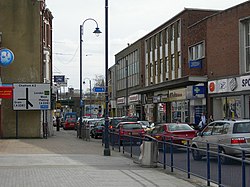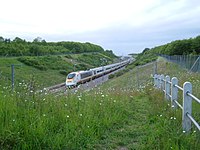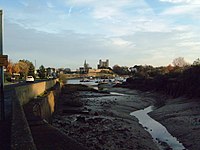Strood: Difference between revisions
Created page with '{{Infobox town |name=Strood |county=Kent |picture=High Street, Strood (3) - geograph.org.uk - 714438.jpg |picture caption=High Street, Strood |os grid ref=TQ725695 |latitude=51.3…' |
m clean up, typos fixed: low lying → low-lying |
||
| Line 97: | Line 97: | ||
All Strood below The Angel Inn, on North Street, near Strood Post Office, was built on marshland which was fed by small creeks, these were excavated to make usable jetties and wharf. Two such creeks are well known, Janes Creek which once extended back to the Cricketers Inn, and Temple Creek. Joining Janes Creek, at a right angle was Pelican Creek which has been in-filled and now forms a car park and the foundations of B&Q. Strood frequently flooded and the area around Temple Street (now a car park and a Tesco) was known as the 'Swamp'. | All Strood below The Angel Inn, on North Street, near Strood Post Office, was built on marshland which was fed by small creeks, these were excavated to make usable jetties and wharf. Two such creeks are well known, Janes Creek which once extended back to the Cricketers Inn, and Temple Creek. Joining Janes Creek, at a right angle was Pelican Creek which has been in-filled and now forms a car park and the foundations of B&Q. Strood frequently flooded and the area around Temple Street (now a car park and a Tesco) was known as the 'Swamp'. | ||
In such a low lying area, flooding is a danger. The reconstruction, after a flood, provides a boost to economy and the opportunity to effect structural change. Floods of significance have been recorded in Strood in the years 1158, 1235, 1309, 1682, 1735, 1791, 1854, 1874, 1887, 1953, 1968 and 1979.<ref name=Coulson/> | In such a low-lying area, flooding is a danger. The reconstruction, after a flood, provides a boost to economy and the opportunity to effect structural change. Floods of significance have been recorded in Strood in the years 1158, 1235, 1309, 1682, 1735, 1791, 1854, 1874, 1887, 1953, 1968 and 1979.<ref name=Coulson/> | ||
William Curel was Medway's oldest establish barge builder, with two yards on the Strood bank. The Curel's Upper Yard was next to the Railway Tavern. In 1900 Gill and Son took over the yard, and it became a sail loft.<ref name=bridge>John K. Austin, Yesterday's Medway from Rochester Bridge to Chatham Intra,2006 Rainmore Books ISBN 0-9553903-0-3</ref> | William Curel was Medway's oldest establish barge builder, with two yards on the Strood bank. The Curel's Upper Yard was next to the Railway Tavern. In 1900 Gill and Son took over the yard, and it became a sail loft.<ref name=bridge>John K. Austin, Yesterday's Medway from Rochester Bridge to Chatham Intra,2006 Rainmore Books ISBN 0-9553903-0-3</ref> | ||
Latest revision as of 21:44, 27 January 2016
| Strood | |
| Kent | |
|---|---|
 High Street, Strood | |
| Location | |
| Grid reference: | TQ725695 |
| Location: | 51°23’35"N, -0°28’41"E |
| Data | |
| Population: | 33,182 |
| Post town: | Rochester |
| Postcode: | ME2 |
| Dialling code: | 01634 |
| Local Government | |
| Council: | Medway |
| Parliamentary constituency: |
Rochester and Strood |
Strood is a town in Kent, on the northwest bank of the River Medway at its lowest bridging point, with Rochester on the opposite bank.
Strood was part of the Parish of Frindsbury until 1193, but now Frindsbury is considered part of Strood. Strood's history has been dominated by the river, the bridges and the road and rail links they carried. It is now a mainly residential suburb of Rochester, and a commuter town for London.
Geography
Strood stands on the edge of marshy land alongside the River Medway. The chalk hills of the North Downs have been breached at this point, forming a river cliff rising to 100 feet directly behind. Two gentle chalk valleys bearing bournes descend to the River Medway here, one takes the A2 towards London on its north slope. Another takes the road to Cliffe, and to Hoo. The land has been extensively quarried for chalk and the covering brickearth. These quarries have then been used for housing. The river frontage has been drained and infilled, firstly for industry, then for transport links, and finally for housing. To the north of Strood are the remains of the canal basin, and to the south the M2 motorway bridge and bridge for the High Speed 1 railway line.
Churches
- Church of England:
- St Nicholas'
- St Francis'
- Independent evangelical:
- Gospel Mission Evangelical Church, Brompton Lane
- Darnley Road Evangelical Church
- Methodist: Wesleyan Methodist Jubilee Church
- Pentecostal: New Testament Church of God, in what was St Mary's Church, Frindsbury
- Roman Catholic:
- English Martyrs
- St Justus
History



Pre-conquest
Strood was part of Frindsbury until 1193. It was named "Strodes" in the Textus Roffensis, though most early records use the spelling Stroud.[1] The name Strod or Stroþ refers to a marshy land overgrown with brushwood.[2]
The Romans built a stone bridge to Rochester here and laid a road on a causeway across the marshy ground.[3] The foundations were about 8 ft below the level of the 1856 road. The road went up Strood Hill, and was in later ages called Watling Street, as it known is today. This is the A2 road. There is further evidence of a causewayed road leading along the bank towards the Frindsbury Peninsula leading to a villa, was found in 1819.[4] The present road and field pattern suggest that there was a substantial Roman agricultural settlement centred near Frindsbury.[4]
In 764 AD Offa King of the Mercians and Sigered King of Kent granted to Eardulph lands in Easlingham (Frindsbury).[3] In 840, 994, and 998 AD Strood was pillaged by the Danes.[3] In 960 AD a wooden bridge was built across the Medway.[3]
Middle Ages
A small wooden church was erected at Strood in 1122, as a chapel of ease in the parish of Frindsbury.[3] Land was granted in 1160 to the Knights Templar by King Henry II. The Manor House was used as a Lodging House.[3]
In 1193, Strood became a parish. It was run by the monks of Newark Hospital, and had its own burial grounds.[3] Corruption in the finances of the Newark Hospital set in and worsened until reforms were put in place formally in 1330 by the Bishop of Rochester Hamo de Hethe. In 1291 there was an affray at Newark Hospital between the Monks of Strood and the locals from Frindsbury.[4]
In 1264 Simon de Montfort laid siege to Rochester Castle from the Strood Side. In the action the wooden bridge was destroyed by fire.[3] After Simon's death a heavy fine was levied on Strood because he had stayed there during the siege.[3] The Strood Quay and Strood Wharf had been built by Bishop de Glanville with rents going to Newark Hospital. In 1293 the Rochester wharf was in such disrepair that ships had to use the Strood facilities, however as the bridge was out of use, ferries had to be used to cross the river.[3] In 1309, a harsh winter, the bridge was damaged by ice.[3] In 1312 the Knight's Templar were suppressed and the Manor of Strood passed into private hands briefly before being passed on to the Abbess and Sisters Minorites of St Clare of Denney in Cambridgeshire.[3] In 1387 a stone bridge was built by John de Cobham and Robert Knolles.[3] In 1460 Edward IV appointed a mayor of Rochester with jurisdiction over Strood river frontage and the houses there.[3]
Early Modern period
Strood was owned by the Rochester monastery from the 18th year of Edward III's reign until the Dissolution of the Monasteries under Henry VIII, after which time it was passed to George Brooke, Lord Cobham. His grandson Henry Brooke lost his estates to James I in 1603 through a charge of treason, although Brooke escaped with his life. The Temple Manor thereafter was granted to Sir Robert Cecil, who served as a chief minister of the realm under Queen Elizabeth and King James.
1554 Thomas Wyatt of Allington, heard that Queen Mary ("Bloody Mary") intended to marry a Roman Catholic and gathered an army with intention of marching to London. He took Rochester Castle and The Bridge. According to Marsh there was to have been a battle at Strood, but the Queen's men deserted.[5] However Coulson records that Wyatt defeated the Duke of Norfolk and seized six cannon. Wyatt then marched on Cooling Castle.[3] The rebellion fizzled out and Wyatt was executed along with captain of the deserters.
Queen mary spent a considerable sum converting the church to Roman worship, though just nine years later in 1565 a further five-year period of refurbishment was required to convert the church back to Protestant usage following the accession of Queen Elizabeth I.[3] The parish registers start from this date. Possibly mindful of the changes, the churchwardens waited until 1574 before going to St. Dunstan's Fair in Rochester to sell "a cross and other relics of Roman superstition, formerly used in Strood Church".[3]
In 1769, under authority of the 1768 Paving Act, a tollgate was erected at The Angel Inn on North Street in Strood, to pay for improvements to the parish. Near the church, some time after the Newark hospital had been replaced, a workhouse was built, funded by the Watts Charity in 1721. Hasted, in his study of Kent (1778–99), said Strood's inhabitants were chiefly seafaring or fishermen, and engaged in dredging oysters.[6]
Nineteenth and Twentieth Centuries
Between 1804 and 1824 the Thames and Medway canal was dug.
Strood Fair
An annual fair was instituted in 1206 during the seventh year of King John's reign to the priory of Rochester, to be held on 26 August, which continued well into the 18th Century, according to Edward Hasted, the Kent historian. It was traditionally held over three days, and associated with pre-Reformation celebration of the Assumption (15 August). The Strood Fair was held regularly into the 1970s. The land used for the Strood Fair was sandwiched between Grange Road and Station Road, adjacent to Strood railway station. It was for many years part of a dairy farm, though by the 1970s the farm building had been turned into a motor repair business. The fair ground was passed on to the people who ran the Strood Fair. It was then used by them to stay through the winter months. Gradually the number or fairs held on the land dwindled.
The land is still occupied as winter quarters by the Showman's Guild with its running costs supported by an annual fair on the site. In June 2007, the motor repair building was demolished to be replaced by flats. Today's market is held on a Tuesday and Saturday, and a boot fair is held on a Sunday.
Newark Hospital
Gilbert de Glanvill, Bishop of Rochester, in 1190, early during the reign of Richard I founded a hospital in Strood, east of the church,[3] which was afterwards called the Newark or Stroud Hospital, the Yoke or North Yoke being a small manor in Strood. Newark Hospital was important in raising the profile of Strood, however there was constant concern about it financial management, and the rivalry between it and the Rochester Priory.
The location of the former Newark Hospital is now mainly a car park behind Strood High Street. The 19th century railway embankment carrying the Chatham Main Line cuts across the back of the old hospital site. Strood Market is held on part of this land, but is relocating to make way for a food store. An archaeological dig of the site was done in the 1970s.
Economy

Small enterprises were formed to service Chatham Dockyard.
Joseph Collis started as a retail ironmonger in 1777. By 1865 he was a wholesaler specialising in zinc, iron, tinplate and locksmithery. By 1870, he and his partner Stace took over the Pelican Foundry and manufactured structural ironwork, toilet cisterns and manhole covers.[7]
Thomas Aveling built his traction engines at the Invicta Works next to Rochester Bridge from 1861. Later the works were acquired the Collis and Stace's Pelican Foundry. Avelings were noted for excellent employment practices, and made their premises available for meetings of co-operative and radical societies. Avelings in turn became Wingets factory,[7] then the Rochester-upon-Medway Civic Centre.
Shorts the seaplane manufacturer used a yard on the Strood side for construction of the airframes of F3 and F5 flying boats.[7]
Local media
- Newspapers:
- The Medway Messenger
- Medway Extra
- yourmedway
- Radio:
- KMFM Medway
- Radio Sunlight
The River and the Strood Basin

All Strood below The Angel Inn, on North Street, near Strood Post Office, was built on marshland which was fed by small creeks, these were excavated to make usable jetties and wharf. Two such creeks are well known, Janes Creek which once extended back to the Cricketers Inn, and Temple Creek. Joining Janes Creek, at a right angle was Pelican Creek which has been in-filled and now forms a car park and the foundations of B&Q. Strood frequently flooded and the area around Temple Street (now a car park and a Tesco) was known as the 'Swamp'.
In such a low-lying area, flooding is a danger. The reconstruction, after a flood, provides a boost to economy and the opportunity to effect structural change. Floods of significance have been recorded in Strood in the years 1158, 1235, 1309, 1682, 1735, 1791, 1854, 1874, 1887, 1953, 1968 and 1979.[3]
William Curel was Medway's oldest establish barge builder, with two yards on the Strood bank. The Curel's Upper Yard was next to the Railway Tavern. In 1900 Gill and Son took over the yard, and it became a sail loft.[7]
Mills
There was a windmill on Strood Hill, two on Broom Hill and 5 in neighbouring Frindsbury.
- The Strood Hill Mill was a smock mill that was demolished in 1860. It was unsuitably sited, and suffered from variable winds The site now forms part of the Cedars Hotel.
- Killicks Mill on Broom Hill cap was blown off for the second time in 1880. It was replaced and worked again for a year in 1890 but was unprofitable and was probably demolished in the 1920s. It had 6 sides rather than the usual 8.
- Fields Mill on Broom Hill burnt down in 1875. In Dickens' times the Miller was a Mr Clark, but the owner was Mr Field. Mr Field was an amateur musician, who kept a piano a harp, and a barrel organ in his sitting room. It is said that the Organ was bought from Loose Church, and so fixed that the power from the mill turned the organ's handle. Dickens would visit the Mill, on his walks and listen to the organ music.[8]
The Frindsbury Mills.
- The oldest was a tripod - or post mill.It was called the Quarry Mill and was 100 yds southeast of the church. Destroyed in 1850.
The other four mills were all owned by Mr Kimmins.
- On Prospect Hill there were two mills. The first was called Manwaring Mill, or Little mill. It was a black tarred smock mill, and it drove four sets of stones. Little Mill was struck by lightning and demolished in 1886.
- Also on Prospect Hill was Great Mill or Rose's Mill. It was the highest in Kent with forty foot by nine foot sweeps. Together the two mills produced 400 sacks of flour a week. Great Mill was demolished in 1890.
- Kimmin's Mill on Frindsbury Hill was a smock mill with no base. The land became a brick field. A man was killed by its sweeps.
- House Mill, also known as Kimmins Mill or Frindsbury Mill, stood on Frindsbury hill and was a black smock mill. It was demolished in 1931.[8]
There was a tidemill. When the tide was rising, water flowed into the mill pond driving a mill, when the tide was falling, water flowed back into the river, driving the mill.
Sport and leisure
- Football: Rochester United FC, formerly Bly Spartans, plays at Bly Spartans Sports Ground in Strood
Outside links
References
- ↑ Parishes – Stroud
- ↑ Placenames of Kent Judith Glover 1976, 1982, 1992 Meresborough Books ISBN 0-905270-61-4
- ↑ 3.00 3.01 3.02 3.03 3.04 3.05 3.06 3.07 3.08 3.09 3.10 3.11 3.12 3.13 3.14 3.15 3.16 3.17 3.18 Coulson ALA, Richard Lewis Harrison; Collins, L.M. (1982), A Chronology of Strood to 1899, Kent County Libraries
- ↑ 4.0 4.1 4.2 Merrily to Frendsbury-A History of the Parish of Frindsbury. Derek Barnard. Private Pub. City of Rochester Society. post 1994.
- ↑ Marsh, A History of Rochester,1976, Medway Borough Council
- ↑ Hasted, Topographical Survey of the County of Kent, 1778-99. Two vols.
- ↑ 7.0 7.1 7.2 7.3 John K. Austin, Yesterday's Medway from Rochester Bridge to Chatham Intra,2006 Rainmore Books ISBN 0-9553903-0-3
- ↑ 8.0 8.1 Windmills and Watermills, William ColesFinch, 1933, pub. C.W. Daniel, reprinted 1976, Arthur J. Cassell Ltd ISBN 978-0-903253-02-4